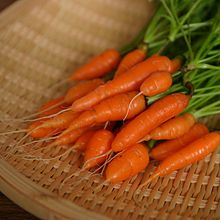Baby carrot
A baby carrot is an immature carrot, grown in a small size, in which it is sold. A baby-cut carrot is a small piece cut from a larger carrot; baby-cut carrots are often marketed as "baby carrots", leading to potential confusion.
Baby carrots

The immature roots of the carrot plant are sometimes harvested simply as the result of crop thinning, but are also grown to this size as a specialty crop.[1] Certain cultivars of carrots have been bred to be used at the "baby" stage. One such cultivar is 'Amsterdam Forcing'. This process was developed at Beechnut Farms, bought by Zellwin Farms. These farms originally developed food for WWII, but wanted to sell food for civilians. A team of two led the research. From an interview, they were originally to be called "carettes".[citation needed] According to Dole, baby carrots are sweeter and more tender than full-grown carrots.[1]
"Baby-cut" carrots

Taking fully grown carrots and cutting them to a smaller size was the brainchild of California carrot farmer Mike Yurosek in 1986.[2] Yurosek was unhappy at having to discard carrots because of slight rotting or imperfections, and looked for a way to reclaim what would otherwise be a waste product. He was able to acquire an industrial green bean cutter, which cut his carrots into two lengths, and by placing these lengths into a potato peeler, he created the original "baby-cut" carrot, branded "Bunny-Luv".
In 2006, nearly three-quarters of the fresh baby-cut carrots produced in the United States came from Bakersfield, California.[2] Bolthouse Farms and Grimmway Farms are the world's two largest growers, processors, and shippers of baby-cut carrots.[3] The Green Giant company, which resells carrots from Bolthouse Farms, markets their product as "baby-cut carrots".
Generally, consumers can determine whether small carrots are true baby carrots or not by looking at what is listed on the packaging. Labels that say "baby carrots" appear on packages of very young carrots that are harvested while the vegetables are still quite tiny. Labels that proclaim "baby-cut carrots" appear on packages of petite carrots made by chopping down and polishing much larger versions of the vegetable.
"Baby-cuts" are part of a sharp upsurge in the carrot's popularity in the United States. Between 1970 and 1986, Americans ate 6 pounds of carrots per person per year. However, American consumption of carrots began to soar in 1987, and by 2002 it had reached 11 pounds per person.
Production
To make "baby-cuts," large carrots are machine cut into 2-inch sections, then abraded (scraped) down to size, their ends rounded by the same process:
- In the field, two-story carrot harvesters use long metal prongs to open up the soil, while rubber belts grab the green tops and pull. The carrots ride up the belts to the top of the picker, where an automated cutter snips off the greens.
- They are trucked to the processing plant, where they are put in icy water to bring their temperature down to 37 degrees Fahrenheit to inhibit spoiling.
- They are sorted by thickness. Thin carrots continue on the processing line; the others will be used as whole carrots, juice, or cattle feed. An inspector looks for rocks, debris or malformed carrots that slip through.
- The carrots are shaped into 2-inch pieces by automated cutters. An optical sorter discards any piece that has green on it.
- The pieces are pumped through pipes to the peeling tanks. The peelers rotate, scraping the skin off the carrots. There are two stages: an initial rough peel and then a final "polishing."
- To reduce microbial contamination, cocktail carrots may be treated with small amounts of chlorine.[4] Those that are will be subsequently rinsed with potable water to remove the excess chlorine before being packaged.[4] According to the Canadian Food Inspection Agency, the use of chlorine as an antimicrobial treatment (similar to the chlorination of drinking water) is a current accepted practice in the processing for all fresh-cut ready-to-eat vegetables.[5]
- The carrots are weighed and bagged by an automated scale and packager, then placed in cold storage until they are shipped.
The white blush sometimes visible on the surface of cocktail carrots is caused by dehydration of the cut surface.[4] Cocktail carrots are more prone to develop this because their entire surface area is a cut surface. Low-temperature, high-humidity storage can minimize the white appearance.[4]
Marketing
In September 2010, a marketing initiative was launched by a group of nearly 50 carrot producers led by Bolthouse Farms (calling themselves "A Bunch of Carrot Farmers") sought to promote baby-cut carrots as an alternative to junk food.[6] The campaign mimicked tactics typically employed by snack food marketers, including snack-food-like packaging; futuristic, sexual, and extreme sports-themed TV commercials; carrot vending machines in schools; and an iPhone game and website.[6]
References
- ^ a b "Baby Carrots". Dole Europe SAS / Dole Packaged Foods Europe SAS. Retrieved March 21, 2009.
- ^ a b Weise, Elizabeth (August 11, 2004). "Digging the baby carrot". USA Today. Archived from the original on March 20, 2014. Retrieved March 20, 2014.
{{cite news}}: Unknown parameter|deadurl=ignored (|url-status=suggested) (help) - ^ McGray, Douglas (March 22, 2011). "How Carrots Became The New Junk Food". Fast Company.
- ^ a b c d Mikkelson, Barbara. "Carrot and Shtick". Snopes.com. Retrieved November 2, 2013.
- ^ http://www.inspection.gc.ca/english/fssa/frefra/safsal/minproe.shtml#s15
- ^ a b Horvitz, Bruce (September 3, 2010). "Baby Carrots Take On Junk Food with Hip Marketing Campaign". USAToday.
